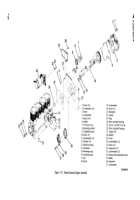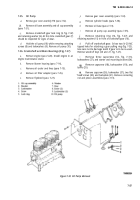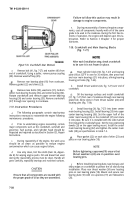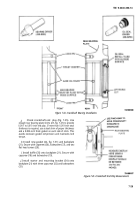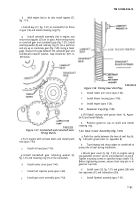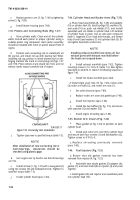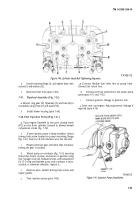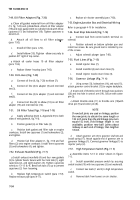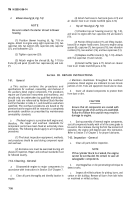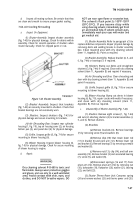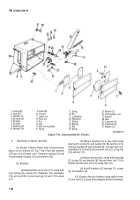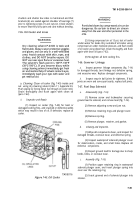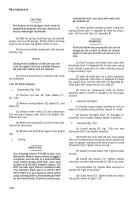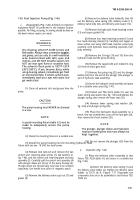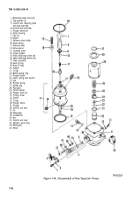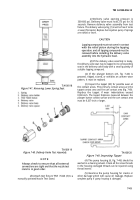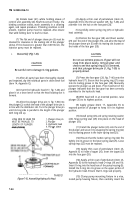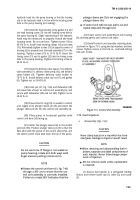TM-9-2330-356-14
SEMITRAILER, TANK: 5000 GALLON, BULK HAUL, SELF LOAD/UNLOAD M967 AND M967A1; SEMITRAILER, TANK: 5000 GALLON, FUEL DISPENSING, AUTOMOTIVE M969 AND M969A1; SEMITRAILER, TANK: 5000 GALLON, FUEL DISPENSING, UNDER/OVERWING AIRCRAFT M970 AND M970A1
TECHNICAL MANUAL; OPERATOR’S, UNIT, DIRECT SUPPORT, AND GENERAL SUPPORT MAINTENANCE MANUAL
OCTOBER 1990
TM-9-2330-356-14 - Page 392 of 528
TM 9-2330-356-14
d.
Blower Housing (6, Fig. 7-9).
NOTE
Be sure to attach the starter shroud to blower
housing.
(1) Position blower housing (6, fig. 7-9) on
engine. Attach to engine using eight capscrews (23), two
capscrews (24), two washers (25), capscrews (26), capscrew
(21), and lockwasher (22).
(2) Tighten capscrew (20).
(3) Attach engine fan shroud (8, fig. 7-10) to
frame (9) and panel (5) with four capscrews (6) and nuts
(7).
(4) Attach fuel hoses to fuel tank (para 4-73) and
air cleaner hose to air intake manifold (para 4-74).
e.
Top Air Housing (2, Fig. 7-9).
(1) Position top air housing cover (2, fig. 7-9),
and secure to engine with four capscrews (18) and washers
(19).
(2) Position lifting bracket (17) and lifting bracket-
brace (9) on engine head covers. Secure to engine using
spacer (8), capscrew (7), two spacers (16), two vibration
cushions (15), two washers (14), and two capscrews (13).
(3) Replace muffler stand (3, fig. 7-10). Attach
with five capscrews (1) and nuts (2).
(4) Install muffler (para 4-77). Attach air cleaner
hose to air intake manifold para 4-74).
Section III. REPAIR INSTRUCTIONS
7-61.
General
a.
This section contains the procedures and
specifications for overhaul, reassembly, and checkout of
the auxiliary diesel engine components. The procedures
require use of precision instruments and machinery, and
should only be undertaken by qualified technicians.
Special
tools are referenced by National Stock Number
and Part Number in table 2-1, and should be used where
specified. The overhaul procedures are based on the
premise that the engine will be restored to a completely
serviceable condition as prescribed by maintenance
serviceability standards.
b.
The
diesel engine is a precision-built engine and,
therefore,
the repair and overhaul standards for
component parts have been fixed at extremely close
tolerances. The following should apply to all inspection
procedures:
(1) The latest inspection equipment, methods,
and procedures should be used during component repair
and overhaul.
(2) Extreme care must be exercised during all
phases of inspection. Repair and overhaul standards must
be followed exactly.
7-62. Cleaning - General
a.
Disassemble engine to major components in
accordance with instructions in Section II of Chapter 7.
b.
Clean all parts thoroughly and identify location in
engine.
c.
Maintain cleanliness throughout the overhaul
procedures. Diesel engines are intolerant to even minute
particles of dirt. Tools and equipment should also be clean.
d.
Cover all cleaned components to protect them
from dust or dirt.
CAUTION
Ensure that all components are coated with
the proper grade of oil as they are assembled.
Failure to follow this caution may result in
damage to engine.
e.
During assembly of internal engine components,
coat all components heavily with oil of the same grade to
be used in the crankcase. During the first few moments of
operation, the engine will depend upon this lubrication.
Refer to Section I of Chapter 3 for proper lubricants.
7-63. Inspection - General
a.
Clean all parts before inspection.
NOTE
If the cylinder block Is cracked, the engine
cannot be overhauled. Be certain to save all
salvageable components.
b.
Use Magnaflux or die penetrating technique to
detect cracks.
c.
Inspect all milled surfaces for pitting, burrs, and
carbon or dirt buildup. Remove all burrs from bolt holes
on machined or milled surfaces.
7-36
Back to Top

